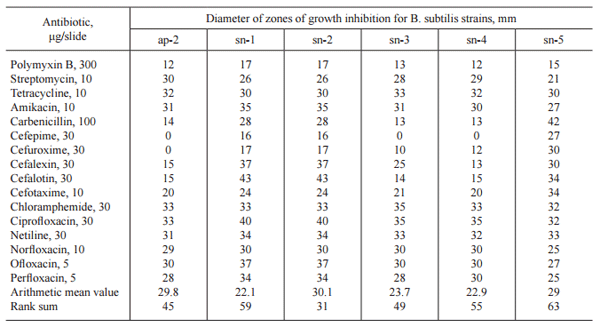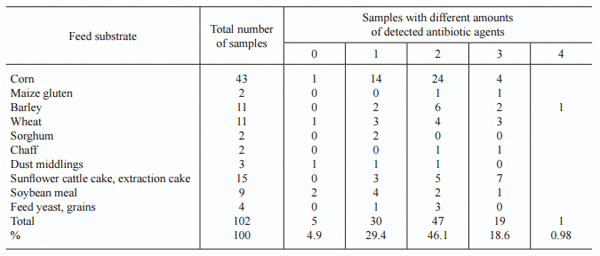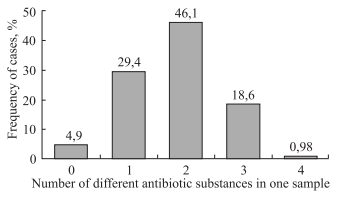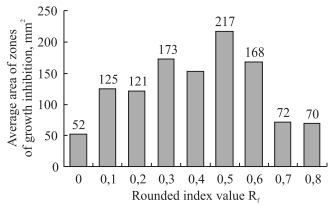INTRODUCTION
The list of maximally acceptable levels of undesired substances in animal feed and fodder in Ukraine includes inorganic pollutants, nitrogen compounds, mycotoxins, toxins of plant origin, chlororganic compounds, dioxins and microelements. The content of coccidiostatics in the composition of pharmaceutical products for veterinary use is specified in case when they are not meant for animals. At the same time the European Union and a number of countries regulate the content of antibiotics in feeds which are prohibited for use as growth promoting agents [2]. Ukraine has not got any restrictions on the content of antibiotics in feeds therefore they are usually not indicated in the list of feed ingredients.
In recent years there have been some communications informing that intentional introduction of veterinary antibiotics into fodder combination is not the only way of contaminating the latter with the substances of antibiotic activity. It was determined that antibiotics may penetrate the agricultural soils with the excrements of animals, fed with the fodder, produced with the addition of antibiotic as growth promoting agents or veterinary antibiotics, prescribed by the veterinary physician [3, 4]. There are published data proving that antibiotics, penetrating the soil from organic fertilizers, may be consumed by the root system of agricultural crops and accumulated in different tissues and organs, including grain [5]. It was determined that microbiocidal agents are capable of being accumulated by plants, cultivated on the soil using solid organic wastes, obtained in the process of purifying wastewater, as fertilizers [6, 7]. Besides, a potential source of antibiotic substances in feeds of plant origin may be metabolites of symbiotic soil [8, 9] and phytopathogenic bacteria [10].
This study was aimed at detecting antibiotics, active against sensitive strains of Bacillus subtilis, in the samples of grain and vegetative feed for farm animals and poultry.
MATERIALS AND METHODS
During 2010–2014 102 samples of feed substrates (corn, maize gluten, barley, wheat, sorghum, chaff, dust middling, sunfl ower oilcake and extraction cake, soybean meal, feed yeast and grains) from the combined feed-processing plants, livestock enterprises and poultry farms of different forms of ownership from eight regions of Ukraine were tested for the presence of antibiotic agents.
The sensitive strain of bacteria was selected out of the strains of B. subtilis from the Museum of the Laboratory of poultry feeding and mycotoxicology of the State Poultry Research Station NAAS of Ukraine, remarkable for even growth in the cultivation medium and absence of sensitivity to mycotoxins, namely − aflatoxin B1, T-2 toxin, HT-2 toxin, deoxynivalenol, fumonisin, zearalenone and aurofusarin. For this purpose the sensitivity of strains of B. subtilis ap-2, sn-1, sn-2, sn-3, sn-4 and sn-5 to antibiotics was tested using the disk diffusion method. Such antibiotics as polymyxin B, streptomycin, tetracycline, amikacin, carbenicillin, cefepime, cefuroxime, cefalexin, cefalotin, cefotaxime, chloramphemide, ciprofloxacin, netiline, norfloxacin, ofloxacin or perfloxacin were applied on paper discs in the amount of 5 to 300 mcg. The cultures of strains were cultivated in Petri dishes in lawns using meatand-peptone agar (MPA). The diameters of the delayed growth zones around the disks with antibiotics were measured and their values were ranged. The selection of the most sensitive strain involved calculation of the rank sum, the arithmetic mean value for the diameters of delayed growth zones and the sensitivity to specific antibiotics.
To detect the antibiotic substances, 25 g of ground grain or combined fodder was introduced into the conical 500 ml fl ask with the addition of 20 ml of the aqueous NaCl solution (10 %, weight/volume) and mixed. Then 120 ml methanol was added; the mixture was shaken for 1 h and fi ltered through a paper fi lter. To precipitate protein admixtures, 100 ml of the fi ltrate was added to 20 ml of the aqueous solution of lead acetate (15 %, weight/volume) and 30 ml of distilled water, mixed and kept for 10 min. The mixture was fi ltered; 120 ml of the fi ltrate was transfered to the separation funnel. To isolate the triglycerides, the fi ltrate was added to 40 ml of hexane and shaken; the lower watermethanol layer was isolated after the phase distribution. The latter was added to 20 ml of hexane twice, shaken each time, and the layer of hexane was isolated after the phase distribution. Then the water-methanol extract in the separation funnel was added 40 ml of chloroform twice, shaken each time. After the phase distribution the lower layer (chloroform) was isolated for further analysis. The chloroform extracts were combined, 5 g of anhydrous sodium sulfate was added for dehydration, shaken and kept for 10 min. The solution was fi ltered, the fi ltrate was evaporated. The dry residue was dissolved in 1–2 ml of benzene, evaporated, and the residue was dissolved in 100 μl of benzene.
The Sorbfi l slides for thin-layer chromatography (TLC) (Imid Ltd, Russian Federation) were applied 10 μl of the extract of the investigated samples, chromatographed in the system of such solvents as ethyl acetate:toluene (3:1, volume/volume) and dried.
To detect the antibiotic agents, the surface of horizontally placed chromatographic slides was applied the melted MPA, which was inoculated with the suspension of a sensitive strain of B. subtilis. The slides were kept in a wet chamber at 32°C for 16–18 h. No growth of a test-microorganism on the slide testifi ed to the presence of an antibiotic agent in the sample. The linear sizes of zones and the indices of their chromatographic motility (Rf ) were taken into consideration.
RESULTS AND DISCUSSION
The investigated strains demonstrated different sensitivity to antibiotics (Table 1). B. subtilis strains sn-1, sn-3 and sn-4 were insensitive to cefepime, and sn-1 – to cefuroxime. B. subtilis strains ap-2, sn-2 and sn-5 demonstrated their sensitivity to each of the investigated antibiotics. B. subtilis strain sn-2 was characterized with the the highest sensitivity to antibiotics both in the average value of the diameter of zones of growth inhibition, and in the rank sum, thus it was selected as a test-microorganism for further studies.
The antibiotic agents, capable of inhibiting the growth of B. subtilis sn-2, were found in 95 % of the investigated samples of feed substrates (Table 2). Therefore, the bioautographic method of applying the sensitive strain of B. subtilis, sn-2, allows revealing the antibiotic substances with different chromatographic characteristics, separating the mixture of several antibiotics and estimating the concentration in relative units of activity. The bioautographic method of applying Escherichia coli was previously used for the purpose of quantitative determination of tabtoxin, mangotoxin and phaseolotoxin – Pseudomonas syringae metabolites, characterized with antibiotic activity [11]. It should be noted that a considerable amount of P. syringae strains are phytopathogenic endophytic microorganisms, causing bacterioses of gramineous plants, due to which they may be the source of grain contamination with antibacterial activity [12].
Most frequently, namely, in 46 % of cases, the samples of grain and vegetable raw materials were simultaneously contaminated with two substances, inhibiting the growth of B. subtilis sn-2 (Fig. 1). Approximately 1.5 times less frequently (i.e. in 29 % cases) there were samples, contaminated with only one antibiotic substance; almost 2.5 times less frequently – samples, contaminated with three antibiotics at the same time. Only the extract of one investigated sample of barley caused four zones of delayed growth of B. subtilis sn-2 on the slide for TLC. It is noteworthy that the distribution of frequencies of simultaneous detection of several antibiotic substances in one sample corresponds to prevailing schemes of applying the antibiotic as growth promoting agent individually and in synergistic combinations [13, 14].
The investigated samples of grain and feed were remarkable for a wide variety of antibiotic substances both by the index of chromatographic mobility and the area of delayed growth zones (Fig. 2). Depending on the average area of zones of growth inhibition with different Rf they can be divided for clarity into four groups. It should be noted that the antibiotic substances with the rounded value of chromatographic mobility index of 0.5 are remarkable for the highest average value of the area of growth inhibition zones of the test-microorganism − 217 mm2 . Somewhat lower areas (from 152 to 173 mm2 ) were registered for the zones of antibiotic substances with rounded Rf values of 0.3, 0.4 and 0.6. The third place in terms of sizes of growth inhibition zones is taken by antibiotic substances with Rf 0.1 and 0.2, the fourth – with 0.7 and 0.8, and the substances, remaining on the start of the TLC slide.
Table 1. The sensitivity of six strains of B. subtilis to antibiotics
Table 2. Number of feed substrate samples with antibiotic substances in the extract
The results of the studies testify that the antibiotic substances with the chromatographic mobility index of 0.5 and the substances, remaining on the start line in the applied system of eluents are registered the most frequently (Fig. 3). The occurrence frequency for these antibiotic substances is 24 and 23 % respectively. The antibiotics with Rf value of 0.1, 0.2, 0.3 and 0.4 were registered with the frequency from 9 to 12 %, with Rf 0.6 and 0.7 – 6 %, and the least frequently − with Rf 0.8 (frequency of 0.5 %).
The detected antibiotic substances don't decrease the wheat grain quality of, rye, barley, triticale, corn, oats, millet, not damaged by insects, fungi and bacteria. They are different in their chromatographic mobility, their capability of inhibiting the growth of test-microorganisms and sizes of zones of absent growth of testmicroorganisms (Fig. 4).
One of the ways of antibiotic substances penetrating into grain and secondary products of oil-seed crops processing (oilcake and extraction cake) is through the soil. Recent articles of different authors contain the data on soil contamination by antibiotics for veterinary purposes which penetrate the soil as a result of fertilizing the latter with the excrements of animals, who were kept using antibiotic growth growth promoting agents or using the schemes of treating the bacterial diseases, presupposing treatment with veterinary antibiotics. For instance, according to the data of Leal et al. [15], 30 % of samples of chicken excrements and 27 % of soil samples from Brazil, Austria, China and Turkey were contaminated with enrofl oxacin in average concentrations of 6.68 mg/kg and 22.93 μg/kg, respectively. The authors believe that the results obtained, indicate veterinary antibiotics to be a potential source of environment pollution, which has been ignored [15]. Recently considerable efforts were taken to elaborate the means for purifi cation of soils and surface water from contamination with sulfonamide antibiotics to prevent the occurrence of resistant strains [16].
Fig. 1. The frequency of simultaneous detection of several antibiotics in different amounts
Fig. 2. The average area of zones of growth inhibition for B. subtilis sn-2 with different values of Rf
Fig. 3. The frequencies of detecting antibiotic substances with different values of chromatographic mobility
Fig. 4. The zones of absent growth of a test-microorganism B. subtilis sn-2 in case of biography of extracts of barley (?) and wheat (B)
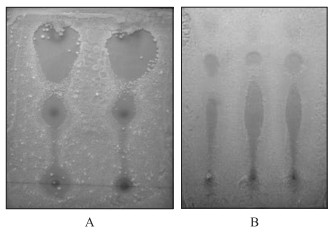
After veterinary antibiotics penetrate the environment, their further destiny is determined by three processes: adsorption by soil particles, biotransformation under the effect of enzymes of microorganisms and bioaccumulation in plant tissues [17]. It was determined that the sorption of sulfadiazine, a veterinary antibiotic, is described with non-linear equations and depends on the level of acidity and type of soil. The study of biotransformation parameters of this antibiotic testifi ed that its half lifetime is in the range from one to six months [18]. According to the experiment, which lasted for 120 days, the periods of half lifetime of erythromycin, oleandomycin, tylosin, tiamulin and salinomycin in soil are 20, 27, 8, 16, and 5 days, respectively. The concentration of roxithromycin did not change during the whole 120-day-period [4]. The results of these studies testify that veterinary antibiotics are stable substances which may remain in soil for a long time.
It should be noted that the experiments, aimed at detecting antibiotics in soil, were conducted in the 50–60s of the previous century to search for new antibiotic substances and their producents. Novel studies, aimed at detecting antibiotics in the soil, emphasize the detection of only veterinary antibiotics which penetrate soils due to human economic activity [19]. The problem of soil contamination with veterinary antibiotics raises the question on the possibility of bioaccumulation of these substances in plant tissues, including agricultural crops. For instance, it was determined that such antibiotics as gentamicin and streptomycin are accumulated in the tissues of carrots (Daucus carota), lettuce (Lactuca sativa) and radish (Rhaphanus sativus), in addition, gentamicin, the molecular mass of which is lower, has more expressed propensity for accumulation [20]. Soybeans may accumulate the substances with antibacterial activity – triclosan, triclocarban and carbamazepine, which are a part of hygiene products and household cleaning products and contaminate soils due to the introduction of products of wastewater cleaning as fertilizers [21].
Then there is a question whether veterinary antibiotic preparations are the only potential source of contamination of plant cultivation products with antibiotics. The substances with antibacterial and antifungal properties are known to be produced by symbiotic bacteria, present in rhizoplane and rhizosphere of cultivated plants and in the root zone of soil [9]. It is quite possible that such antibiotic substances may be absorbed by the root system of plants and get accumulated in different tissues and organs, including fruit and seeds.
One more possible source of antibiotic substances in grain may be phytopathogenic and opportunistic pathogenic endophytic bacteria. Recently there have been some communications on the aggravation of the problem of bacterioses of cultivated crops due to wide-scale application of pesticides with fungicidal activity to protect cultivated plants of from fungal diseases [22]. It was determined that fungicides inhibit the development of both fungi as pathogens and representatives of fungal saprotrophic soil microfl ora. Due to the emptying of ecological niches, previously taken by saprotrophic fungi, namely, crop debris, there is uncontrolled development of bacteria, a considerable part of which belongs to phytopathogenic species.
Phytopathogenic bacteria are capable of penetrating the transport vessels of plants and getting accumulated in grain, producing a wide spectrum of antibiotic substances and compounds, toxic to eukaryotic organisms, including mammals. For instance, Pseudomonas syringaeatrofaciens is an agent, causing bacteriosis of barley endosperm, one of the consequences of which is the deterioration in quality of grain and fl our [23]. An interseasonal factor of the transmission of most agents of bacterial diseases of gramineous plants is seeds, i.e. bacterial cells get accumulated in grain during its development and infect the sprouts during the germination. It is quite probable that the products of bacterial synthesis, including antibiotics, also get accumulated in grain. It is known that P. syringae is the producent of antibiotic substances, such as tabtoxin, phaseolotoxin and mangotoxin, harmful both for bacteria [12] and for mammals [24, 25].
CONCLUSIONS
The data obtained testify to high frequency and considerable levels of grain contamination of gramineous plants and secondary products of seed processing of oil-seed crops with antibiotic substances, active against B. subtilis strain, rather sensitive to a wide spectrum of antibiotics. The differences in the indices of chromatographic mobility testify to a high variety of physical properties, and therefore, chemical structures of the antibiotic substances revealed. The contamination of grain and vegetative raw material with antibiotics is of potential risk to the environment, health of farm animals and humans. Further studies are planned for the identifi cation of the detected antibiotic substances, the investigation of their impact on the environment and living organisms as well as determination of sources of their penetration into grain and other tissues and organs of cultivated plants.
REFERENCES
1. Nakaz Ministerstva agrarnoi’ polityky ta prodovol’stva Ukrai’ny vid 19 bereznja 2012 roku N 131. Perelik maksymal’no dopustymyh rivniv nebazhanyh rechovyn u kormah ta kormovij syrovyni dlja tvaryn. Ofi cijnyj visnyk Ukrai’ny.2012; (29).
2. Regulation (EC) No 1831/2003 of the European Parliament and the Council of 22 September 2003 on additives for use in animal nutrition. Offi cial Journal of European Union. L 268,2003;29−43.
3. Velagaleti RR. Behavior of pharmaceutical drugs (human and animal health) in the environment. Ther Innov Regul Sci.1997; 31(3):715−22.
4. Schlusener MP, Bester K. Persistence of antibiotics such as macrolides, tiamulin and salinomycin in soil. Environ Pollut.2006; 143(3):565−71.
5. Dolliver H, Kumar K, Gupta S. Sulfamethazine uptake by plants from manure-amended soil. J Environ Qual. 2007; 36(4):1224−30.
6. Pannu MW, Toor GS, O’Connor GA, Wilson PC. Toxicity and bioaccumulation of biosolids-borne triclosan in food crops. Environ Toxicol Chem.2012; 31(9):2130−7.
7. Prosser RS, Lissemore L, Topp E, Sibley PK. Bioaccumulation of triclosan and triclocarban in plants grown in soils amended with municipal dewatered biosolids. Environ Toxicol Chem. 2014; 33(5):975−84.
8. Bonsall RF, Thomashow LS, Mavrodi DV, Weller DM. Extraction and detection of antibiotics in the rhizosphere metabolome. Curr Trends Mass Spectrom. (Suppl. Spectrosc.)2007; 11:14–9.
9. Mavrodi DV, Mavrodi OV, Parejko JA, Bonsall RF, Kwak YS, Paulitz TC, Thomashow LS, Weller DM. Accumulation of the antibiotic phenazine-1-carboxylic acid in the rhizosphere of dryland cereals. Appl Environ Microbiol. 2012; 78(3):804–12.
10. Bender CL, Alarcon-Chaidez F, Gross DC. Pseudomonas syringae phytotoxins: mode of action, regulation, and biosynthesis by peptide and polyketide synthetases. Microbiol Mol Biol Rev.1999;63(2):266–92.
11. Arrebola E, Cazorla FM, Duran VE, Rivera E, Olea F, Codina JC, Perez-Garcia A, de Vicente A. Mangotoxin: a novel antimetabolite toxin produced by Pseudomonas syringae inhibiting ornithine/arginine biosynthesis. Physiol Mol Plant Pathol.2003;63(3):117–27.
12. Arrebola E, Cazorla FM, Perez-Garcia A, de Vicente A. Chemical and metabolic aspects of antimetabolites toxins produced by Pseudomonas syringae pathovars. Toxins(Basel).2011; 3(9):1089−110.
13. Landers TF, Cohen B, Wittum TE, Larson EL. A review of antibiotic use in food animals: perspective, policy, and potential. Public Health Rep.2012; 127(1):4–22.
14. Agunos A, Leger D, Carson C. Review of antimicrobial therapy of selected bacterial diseases in broiler chickens in Canada. Can Vet J.2012;53(12):1289–300.
15. Leal RM, Figueira RF, Tornisielo VL, Regitano JB. Occurrence and sorption of fl uoroquinolones in poultry litters and soils from Sao Paulo State, Brazil. Sci Total Environ.2012;432:344–9.
16. Martucci A, Braschi I, Marchese L, Quartieri S. Recent advances in clean-up strategies of waters polluted with sulfonamide antibiotics: a review of sorbents and related properties. Mineralogical Magazine. 2014; 78(5): 1115−40.
17. Sassman SA, Sarmah AK, Lee LS. Sorption of tylosin A, D, and A-aldol and degradation of tylosin A in soils. Environ Toxicol Chem.2007; 26(8):1629−35.
18. Kasteel R, Mboh CM, Unold M, Groeneweg J, Vanderborght J, Vereecken H. Transformation and sorption of the veterinary antibioticsulfadiazine in two soils: a shortterm batch study. Environ Sci Technol. 2010; 44(12): 4651−7.
19. Subbiah M, Mitchell SM, Ullman JL, Call DR. β-lactams and fl orfenicol antibiotics remain bioactive in soils while ciprofl oxacin, neomycin, and tetracycline are neutralized. Appl Environ Microbiol.2011; 77(20):7255−60.
20. Bassil RJ, Bashour II, Sleiman FT, Abou-Jawdeh YA. Antibiotic uptake by plants from manure-amended soils. J Environ Sci Health B.2013; 48(7):570−4.
21. Wu C, Spongberg AL, Witter JD, Fang M, Czajkowski KP. Uptake of pharmaceutical and personal care products by soybean plants from soils applied with biosolids and irrigated with contaminated water. Environ Sci Technol. 010; 44(16):6157−61.
22. Gvozdjak RI, Pasichnyk LA, Jakovleva LM. Fitopatogenni bakterii’. Bakterial’ni hvoroby roslyn: Monografi ja. Kyiv, TOV «NVP «Interservis».2011; 444 p.
23. Schober-Butin B, Garbe V, Bartels G. Farbatlas Krankheiten und Schadlinge an Landwirtschaftlichen Kulturpfl anzen: Kartoffel, Zuckerrübe, Raps, Getreide, Mais, Sonnenblume, Hanf. Stuttgart, Eugen Ulmer.1999; 240 S.
24. Lamar CJr, Sinden SL, Durbin RD, Uchytil TF. The production of convulsions by an exotoxin from Pseudomonas tabaci. Toxicol Appl Pharmacol.1969; 14(1):82−8.
25. Sinden SL, Durbin RD. Glutamine synthetase inhibition: possible mode of action of wildfi re toxin from Pseudomonas tabaci. Nature. 1968;219(5152):379−380.
ISSN: 2312-3370, Agricultural Science and Practice, 2015, Vol. 2, No. 1
